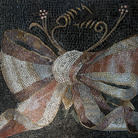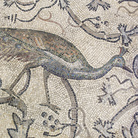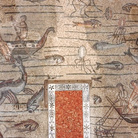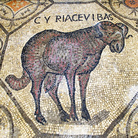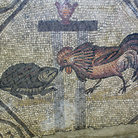AQUILEIA
PATRIMONIO DELL'UMANITÀ
venerdì 5 dicembre 2025
5 unmissable mosaic masterpieces in Aquileia
One of the twelve lambs of the mosaic floor of the Early Christian Basilica of Aquileia, today preserved in the Early Christian Museum | Photo: © Gianluca Baronchelli
For those who visit Aquileia for the first time, the vast collection of mosaic treasures that today are kept in various places is a happy discovery: inside the Basilica of Santa Maria Assunta, in the contiguous exhibition spaces of the Südhalle, in the rooms of the Paleochristian Museum and the National Archaeological Museum, and in the Domus found in the excavation areas.
Spectacular is the Mosaic of the Good Shepherd with a singular dress (currently undergoing restoration) which decorated a large representative room in the domus of Tito Macro. The work proposes recurring figurative themes in the artistic culture of the fourth century: the figure of the good shepherd, with the typical stick and sheep behind him, is surrounded by decorations depicting vine shoots, pheasants and peacocks.
Let's move now to the Basilica of Aquileia. Discovered between the end of the nineteenth century and the first decades of the twentieth century, the mosaic floor of the Basilica represents one of the most incredible testimonies of the ancient early Christian complex.
In the South Hall it is possible to admire the largest mosaic floor in all of the Roman West: on its 760 square meters of extension, we can recognize symbolic images and figurative allegories that indicated the way to salvation to the faithful.
At the National Archaeological Museum, on the other hand, the delicate Mosaic of the Knotted Bow, made with very small tiles in bright colors, which once decorated the central house of the Cossar fund, arouses astonishment. Following the ribbon woven into a bow together with vine shoots, the guests of the landlord, most likely an eminent character from Aquileia who lived at the end of the 1st century BC, entered the banquet hall.
Still vine shoots, leaves and clusters, with some hanging containers are the figures of the tessellated apse of the early Christian Basilica, now preserved in the Palocristiano Museum.
Among the branches are represented twelve lambs in different attitudes and numerous birds, among which a peacock in the left sector and a rooster in the right one stand out.
Do not miss the splendid mosaic fragment depicting a peacock, which today shines in the museum space of the Südhalle. A symbol of immortality and an allegory of the resurrection, the peacock is represented here frontally, with its tail feathers proudly unfolded. The work is made up of glass paste tesserae on a white background, with shades ranging from midnight blue to yellow, from turquoise to ocher, from brown to emerald green, and combined to reproduce shadows and volumes.
Spectacular is the Mosaic of the Good Shepherd with a singular dress (currently undergoing restoration) which decorated a large representative room in the domus of Tito Macro. The work proposes recurring figurative themes in the artistic culture of the fourth century: the figure of the good shepherd, with the typical stick and sheep behind him, is surrounded by decorations depicting vine shoots, pheasants and peacocks.
Let's move now to the Basilica of Aquileia. Discovered between the end of the nineteenth century and the first decades of the twentieth century, the mosaic floor of the Basilica represents one of the most incredible testimonies of the ancient early Christian complex.
In the South Hall it is possible to admire the largest mosaic floor in all of the Roman West: on its 760 square meters of extension, we can recognize symbolic images and figurative allegories that indicated the way to salvation to the faithful.
At the National Archaeological Museum, on the other hand, the delicate Mosaic of the Knotted Bow, made with very small tiles in bright colors, which once decorated the central house of the Cossar fund, arouses astonishment. Following the ribbon woven into a bow together with vine shoots, the guests of the landlord, most likely an eminent character from Aquileia who lived at the end of the 1st century BC, entered the banquet hall.
Still vine shoots, leaves and clusters, with some hanging containers are the figures of the tessellated apse of the early Christian Basilica, now preserved in the Palocristiano Museum.
Among the branches are represented twelve lambs in different attitudes and numerous birds, among which a peacock in the left sector and a rooster in the right one stand out.
Do not miss the splendid mosaic fragment depicting a peacock, which today shines in the museum space of the Südhalle. A symbol of immortality and an allegory of the resurrection, the peacock is represented here frontally, with its tail feathers proudly unfolded. The work is made up of glass paste tesserae on a white background, with shades ranging from midnight blue to yellow, from turquoise to ocher, from brown to emerald green, and combined to reproduce shadows and volumes.



